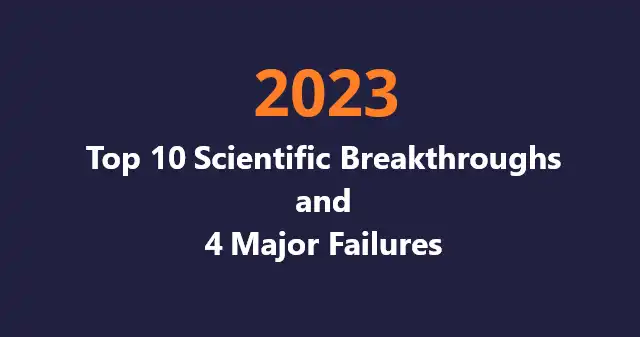Top 10 Scientific Breakthroughs and 4 Major Failures of 2023
- Normal Liver Cells Found to Promote Cancer Metastasis to the Liver
- Nearly 80% Complete Remission: Breakthrough in ADC Anti-Tumor Treatment
- Vaccination Against Common Diseases May Prevent Dementia!
- New Alzheimer’s Disease (AD) Diagnosis and Staging Criteria
- Breakthrough in Alzheimer’s Disease: New Nasal Spray Halts Cognitive Decline by Targeting Toxic Protein
- Can the Tap Water at the Paris Olympics be Drunk Directly?
Top 10 Scientific Breakthroughs and 4 Major Failures of 2023
- Should China be held legally responsible for the US’s $18 trillion COVID losses?
- CT Radiation Exposure Linked to Blood Cancer in Children and Adolescents
- FDA has mandated a top-level black box warning for all marketed CAR-T therapies
- Can people with high blood pressure eat peanuts?
- What is the difference between dopamine and dobutamine?
- How long can the patient live after heart stent surgery?
Top 10 Scientific Breakthroughs and 4 Major Failures of 2023, According to Science Magazine
On December 15th, Science Magazine unveiled its list of the top 10 scientific breakthroughs and four major failures of 2023.
Top 10 Scientific Breakthroughs of 2023:
-
GLP-1 Weight Loss Drug Holds Promise Against Obesity: Topping the list is the prospect of GLP-1, a type of weight loss drug, triumphing over obesity. Initially developed for diabetes treatment, these drugs have shown significant weight reduction in clinical trials, along with cardiovascular benefits. The breakthrough reshapes the approach to obesity treatment, emphasizing it as a chronic biological condition rather than a simple lack of willpower.
-
Antibody Therapy Slowing Neurodegeneration in Alzheimer’s Patients: Progress has been made in slowing down Alzheimer’s disease with antibody therapy. Leqembi and Donanemab, in clinical trials, demonstrated a notable slowdown in cognitive decline in Alzheimer’s patients, with Leqembi gaining regulatory approval in the United States and Japan.
-
Discovery of Natural Hydrogen Sources Below Earth’s Surface: A surge in the search for natural hydrogen sources has led numerous energy companies to initiate research on extracting underground hydrogen as fuel.
-
Systemic Changes in the Treatment of Early-Career Scientists Globally: Efforts to systematically change the treatment of early-career scientists globally have been initiated, responding to academic workers striking in various locations due to treatment issues.
-
Arrival of the Era of Exascale Supercomputing: The era of exascale supercomputing has arrived, with the U.S. supercomputer “Frontier” opening up to scientific users.
-
Development of Artificial Intelligence-Assisted Weather Forecasting: The development of artificial intelligence (AI)-assisted weather forecasting, where AI models predict weather more accurately, efficiently, and at a lower cost.
-
Earth’s Crucial Carbon Pump Slowing Down: The Earth’s carbon pump, a vital process capturing one-third of human-emitted carbon through ocean circulation, is slowing down, posing a crisis as ocean currents significantly decelerate.
-
Confirmation of Ancient Human Footprints Found in a New Mexico Lake: Revealing the historical truth about the settlement of ancient humans in the Americas, with the discovery of human footprints dating back 20,000 years in a lake in New Mexico.
-
Interstellar Signals Generated by Massive Black Hole Mergers: Detection of interstellar signals generated by massive black hole mergers through the detection of gravitational waves.
-
New Malaria Vaccine: The development of a new malaria vaccine.

Four Major Failures of 2023:
Science Magazine also highlighted four major failures of 2023:
-
Room Temperature Superconductivity Controversy: The controversy surrounding room temperature superconductivity, including the retraction of multiple papers by U.S. physicist Ranga Dias due to data authenticity issues and the overturning of claims by Korean scientists regarding LK-99 achieving room temperature superconductivity.
-
Issues with the U.S. Antarctic Program (USAP): Reductions in the U.S. Antarctic Program (USAP) due to problems such as harassment and the impact of the pandemic.
-
Post-COVID “Aftershocks” and Twitter Exodus: The aftermath of COVID, significant seismic disturbances in the scientific community, and a mass exodus of scientists from Twitter, coupled with Twitter ceasing data sharing with researchers.
These breakthroughs and failures mark significant advancements and challenges in the scientific landscape of 2023.
About GLP-1:
Addressing obesity has been a longstanding challenge in the fields of science and public health. However, the stigma attached to overweight individuals has been a persistent issue in the course of obesity drug treatments, associating it with weak willpower rather than biological and chemical factors.
Now, a new drug therapy for weight loss has emerged with more promising results. Landmark clinical trials this year have shown that GLP-1 receptor agonists, originally developed for diabetes treatment, produce more meaningful health benefits beyond weight loss. Ongoing research is investigating their effectiveness in treating drug addiction, Alzheimer’s disease, and Parkinson’s disease.
Science Magazine’s editor-in-chief, Holden Sop, stated in a related editorial, “While GLP-1 receptor agonists show promise, they pose far more questions than answers, and that is the true hallmark of a breakthrough.”
Commentaries suggest that the development of GLP-1 drugs will reshape discussions on obesity, helping to reduce the stigma associated with excess weight. However, concerns about the cost, accessibility, potential side effects, and the need for indefinite usage persist. Despite current understanding of lower side effects, there are still potential risks, such as intestinal obstruction and pancreatitis. Additionally, researchers report that two-thirds of the weight is regained a year after discontinuation.
The high cost remains another side effect. For researchers studying obesity as a chronic disease, the necessity of ongoing treatment is not surprising, but the high prices of these drugs may deter many, with monthly costs exceeding $1,000, and the prospect of lifelong usage troubling for many.
Against this backdrop, more efficient and affordable GLP-1 drugs are under development, reshaping the treatment of obesity in the near future.
Top 10 Scientific Breakthroughs and 4 Major Failures of 2023, According to Science Magazine
(source:internet, reference only)
Disclaimer of medicaltrend.org
Important Note: The information provided is for informational purposes only and should not be considered as medical advice.



